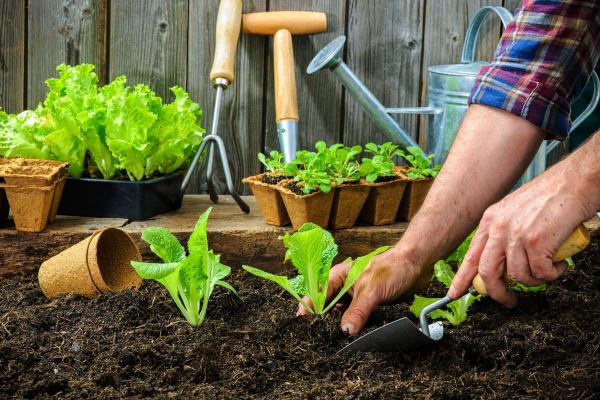Dripping Gardening April 2

The headline in a small pamphlet released by the National War Garden Commission in 1919 simply read, “Small things count!” In April of 1917 the US had entered World War I and there were real fears of major food shortages both at home and on the frontlines. And though the illustrations were incredibly cute, the wording was serious: “Prevention of widespread starvation is the peacetime obligation of the United States. The War Garden of 1918 must become the Victory Garden of 1919.”
The victory garden movement was off and running. Americans cheerfully grew food in whatever empty space they could find, gardens on rooftops, fire escapes, empty lots, and backyards all became the norm. The thinking at the time was that there was nothing more valuable than self-sufficiency. Think about that for a moment, “Nothing more valuable than self-sufficiency,” now there is a lesson all of us need to revisit. People from coast to coast “did their bit” by working a little land, no matter how small, and harvesting their own veggies.
Early in the twentieth century, the nation was facing hard times, the effects of the Great Depression were still being felt, Europe and Asia erupted into war, and victory gardens came back into fashion. With fresh fruits and vegetables in short supply, food needed to be rationed and the government ultimately turned to the citizens to do their part to keep the nation fed. Families on the home front were encouraged to “put their idle land to work” and to once again produce “victory” gardens to combat the food shortage.
Slogans such as “Dig for Victory,” “Sow the Seeds of Victory,” and “Uncle Sam Says, ‘Garden to Cut Food Costs’” covered pamphlets. People quickly realized it was their national duty to participate. It worked too, in 1943, I’ve read that nearly forty percent of all fruits and vegetables grown in the US were grown in victory gardens. There were gardens planted in backyards, empty lots, and on the top of city rooftops. Neighbors and communities worked together and formed co-ops. An estimated 20 million victory gardens were planted, with about 10 million tons of fruits or vegetables harvested. Even Eleanor Roosevelt took part by planting her own victory garden on the lawns of the White House in 1943.
The victory garden idea resonates again today as trips to the grocery store become fraught with fears of coronavirus exposure, and shoppers are frustrated with limited store inventory due to panic buying by some.
Right now, I think we can all use a break from the cable talking heads. So turn off the TV, grab your garden gloves and head out to the yard.
For generations gardeners have known the zen of growing things. All that planting, watering, weeding, and all the beauty that emerges as a result is good for you. And science is catching on, too, with numerous studies showing that gardening can improve your physical and emotional well-being.
Whether it’s a few plants in the windowsill, containers on a deck, beds and borders in the yard or a vegetable plot-- gardens big and small can reap big benefits for you, your family, and yes, even our country.
According to the Mayo Clinic, stress is hard on our bodies and contributes to anxiety, depression and chronic illness, such as heart disease and diabetes. Plus, the stress leaves us both emotionally and physically drained. That’s why finding healthy ways to cope and take care of your mind and body are so important. Incredibly, spending time in nature can help keep things under control. Many studies have shown that working in the garden reduces cortisol levels, even more than relaxing by reading a book (with apologies to my librarian friends). Just sitting in a garden helps, too. So get out and sow some seeds, do a little watering, cut a bouquet, or pull weeds and you’ll soon find that time has flown and cares that were pressing in on you earlier have receded further into the distance than social distancing standards require.
We’re fascinated by nature and this curiosity can help us better cope with life’s challenges. One study I read showed that engaging with a garden distracts us from our worries and stops us from obsessing about the world’s problems. In that 12 week study, participants saw an improvement in the severity of their depression during and immediately after the gardening activity of the study, and three months later, they still reported significant improvements!
In Japan, researchers discovered that spending 30 minutes in the woods could not only lower stress levels but could also improve heart rates and blood pressure. Similarly, another study showed that after just 30 minutes of gardening, participants’ stress levels dropped, and their moods were boosted by the activity.
The takeaway? Spending just half an hour with your hands in the soil, surrounded by the bounty that nature offers, can provide serious benefits for your body, mind and overall health.
If you’ve never gardened before, you might feel overwhelmed by the prospect of starting a garden.
But I want to emphasize one important caveat. The key is to start small and keep it simple. You don’t have to tear up your whole backyard and plant a farm. Be realistic about the time and effort you’re willing to put into it. The last thing you want is to be stressed out about your stress-relieving garden!
I would rather have happily plant just one shrub, then sit back and enjoy your work with a beer, then to rush into a new landscaping plan, only to discover you’ve over-committed.
Remember, while it’s great to listen to suggestions and advice from experienced “green thumbs,” this garden needs to be all about you. No, you don’t need a specific type of shoes or apron to do this. Yes, starting with a few potted plants on your porch counts. Gardening is an escape and a hobby, so as soon as it starts feeling like a chore, simplify!
When you step out to your garden, give yourself permission to leave the world behind. Thirty minutes from now, everything will be right where you left it. Leave the texting, emails, and especially social media behind. When it’s time to weed, plant, and harvest, allow yourself to slow down and disconnect. Give yourself permission to live in the moment. Notice the birds chirping, the ladybug on a leaf, or the gentle breeze in your hair.
One of the major problems of modern life is that we live more in our phone and computer screens than we do in the real world—and that robs us of something.
And so were back to the point I started with—consider planting a garden. Aside from the zen of yardwork and keeping busy, you’ll have the added benefit of growing fruits and vegetables, fresh produce to enjoy. And I guarantee no salad tastes better, than the one you grow yourself.
Even if you’ve never had a green thumb, give it a try. Set aside 30 minutes, start small, enjoy our springe weather, and see what happens. You might be surprised by how much you enjoy it and how much better you feel!



